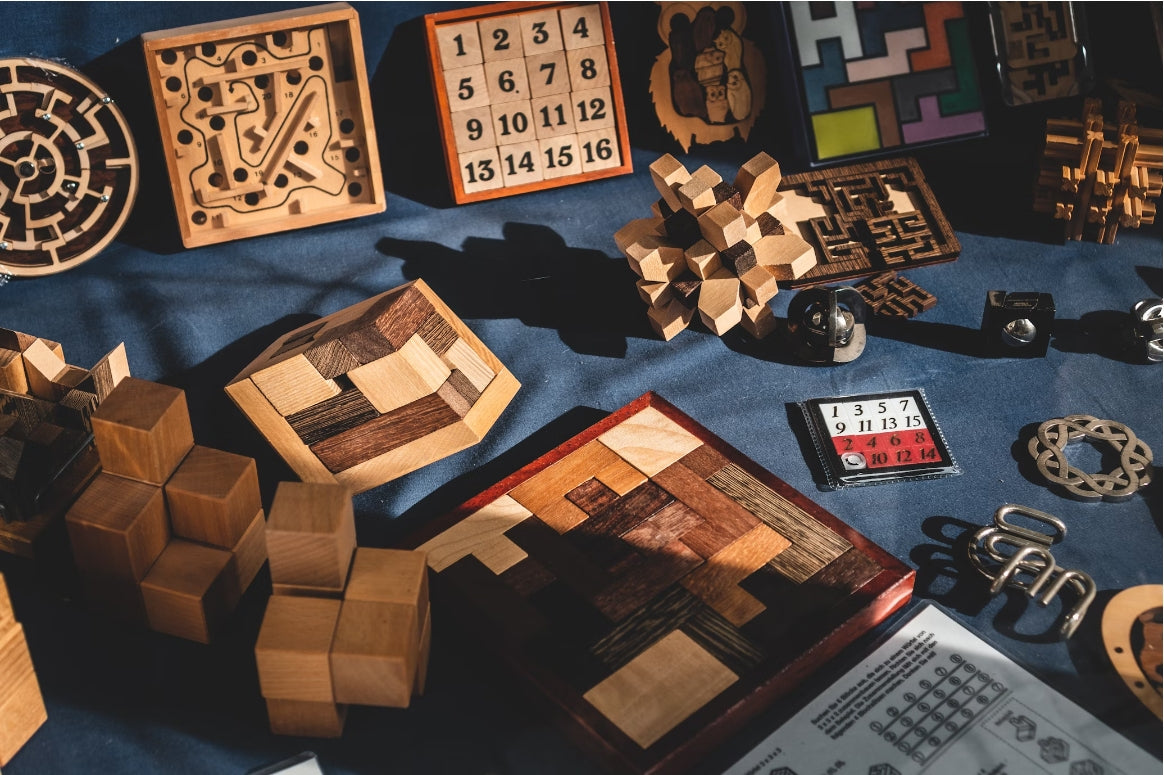
How Difficult Are 3D Mechanical Puzzles to Solve?

All mechanical puzzles require logic and deductive reasoning, but what about their 3D variations? Is assembling them trickier? It depends on the puzzle. Some take an hour to solve, while their more challenging counterparts can have you combining their parts for hours.
Let’s see what mechanical 3D puzzles are before exploring their difficulty levels, solving tips, and benefits.
What Are Mechanical 3D Puzzles?
Mechanical 3D puzzles include interlinked pieces you must manipulate to solve a problem. Some have many intricate parts with grooves or holes that you must assemble to create a 3D model. Others are already assembled and require moving specific pieces (sometimes in a correct sequence) to disentangle them, solve a challenge, or unlock hidden compartments.
The Rubik’s Cube is the most famous 3D mechanical puzzle, but hundreds of others exist. Modern designs typically feature disassembled puzzles, providing instructions on piecing them together.
3D metal puzzles often have kits like screwdriver sets because they have many gears and screws, sometimes resembling watch mechanisms. Solving those can be more challenging, but that makes them more exciting.
Mechanical 3D Puzzles’ Levels of Difficulty

Image Source: Unsplash
Mechanical 3D puzzles typically have three difficulty levels:
- Easy – They take about an hour to solve and are suitable for beginners.
- Medium – They require approximately three hours and usually have a 14+ age rating.
- Advanced – These take several hours or even a day to solve and are ideal for seasoned puzzle enthusiasts.
Many determine puzzle difficulty using the number of pieces to assemble. A general rule of thumb is that fewer pieces mean solving a puzzle faster.
However, some mechanical puzzles are exceptions. They can have you scratching your head for days to see which parts to move in a specific direction or sequence to unlock them. Solving them can take significantly longer than a disassembled puzzle with 500 pieces, for which you have a map and instructions.
Tips for Solving 3D Mechanical Puzzles
Solving 3D mechanical puzzles doesn’t have a one-size-fits-all approach. Take the Rubik’s Cube, for example. It doesn’t have instructions or a map to read. Instead, it requires pattern recognition, spatial awareness, and muscle memory. The same goes for sequential (and similar) puzzles, which require critical thinking skills like problem-solving.
As for other mechanical 3D puzzles requiring assembling various parts, follow these tips to solve them quickly:
- Read the instructions – They may seem boring or unnecessary, but they exist for a reason. You don’t want to miss a part at some point and realize your mistake too late, having to start from scratch.
- Visualize the 3D model – Thoroughly examine the map, visualizing how all the intricate parts fit together to make the finished object. Spatial awareness and imagination will help you plan the assembly.
- Take out the pieces in order – If your 3D mechanical puzzle has a flat board with all the pieces, don’t take everything out, primarily if they’re numbered. Otherwise, assembling them will be more challenging and time-consuming.
- Gently manipulate the parts – This tip goes without saying. Don’t use force when handling the pieces. You don’t want to damage them and ruin the puzzle.
Now that you know how to solve 3D mechanical puzzles, it’s time to see what benefits you can expect.
Benefits of Solving Mechanical 3D Puzzles

Image Source: Unsplash
Mechanical 3D puzzles provide many benefits, including the following:
- Improved critical thinking – Solving mechanical puzzles’ challenges requires analytical, creative thinking, and problem-solving skills. That makes them ideal for people of all ages.
- Enhanced cognitive skills – Flexing your brain muscles while solving mechanical puzzles improves focus, memory, logical reasoning, visual processing, and spatial reasoning. That makes them perfect for brain development and potentially staving off cognitive decline.
- Stress relief – 3D mechanical puzzles provide hours of entertainment, reducing stress and improving mood. They help you focus all attention on solving them, diverting it from stressors and relaxing you.
These benefits are fantastic, but no one ever says they solve 3D mechanical puzzles to improve critical thinking or focus. Most people cite other reasons. Here are the most notable.
Why People Love 3D Mechanical Puzzles
People love these puzzles because they’re fun. They love the entire process, from manipulating multiple pieces to seeing the result and enjoying a sense of accomplishment. Mechanical 3D puzzles help them unwind after a busy work day, forget about problems for a while, or simply immerse themselves in an exciting activity.
Many also love a challenge. Mechanical puzzles let them solve logical or analytical problems, providing a sense of achievement and mental reward.
Top 3D Mechanical Puzzles to Try
If you love 3D mechanical puzzles doubling as beautiful cyberpunk decoration, you’ll love Vivillon, a 3D metal butterfly puzzle. It features 125 pieces and has a medium difficulty level. The best part is you can swap the butterfly’s magnetic wings – you get three pairs.

Another 3D mechanical puzzle to exercise your brain is Phantom, featuring a metal sci-fi butterfly with a longer assembly time (approximately 3.5 hours). Besides having fun assembling it, you’ll love how gorgeous it looks on a shelf, primarily because of its reflective wings.

Conclusion
Mechanical 3D puzzles may sometimes test your patience, but you’ll enjoy the thrill of solving them. Everyone should have at least one in their puzzle collection, if not for the fun of completing them, then for the excellent benefits they provide.

